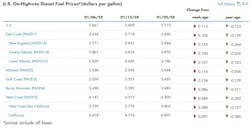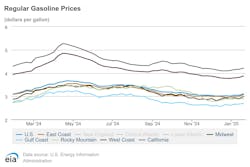The week of Martin Luther King Jr. Day, as a cold front hit the country, the U.S. Energy Information Administration reported gas and diesel prices increased nationwide. For diesel, the pump prices increased 11 cents, rising to a $3.715-per-gallon nationwide average, 12 cents lower than this time last year. Regionally, diesel prices rose between 8 and 13 cents.
The Gulf Coast, Midwest, and East Coast (along with subregions) all saw double-digit diesel pump price increases this week as snow, ice, and single-digit temperatures plague much of the Southern U.S. and Eastern Seaboard.
The regions that felt the lower end of the frigid price increase were the Rocky Mountains, the West Coast overall, and the West Coast without California. All saw their diesel price average increase by 8 cents. This put retail diesel prices at $3.485 per gallon in the Rocky Mountains, $4.302 along the West Coast overall, and $3.865 per gallon along the West Coast without California. Additionally, California’s diesel prices rose by 9 cents, with the state’s average reaching $4.807 per gallon.
See also: EIA anticipates higher oil production, lower pump prices in 2025
While the Rocky Mountain region’s prices are inching closer to those along the Gulf Coast, the latter is still the cheapest place to buy diesel fuel this week. Meanwhile, California remains the most expensive.
As a point of comparison, the AAA motor club found that diesel prices rose this week as well. Their current price was $3.650 per gallon, 6 cents less expensive than the EIA’s estimate and 8 cents more expensive than last week’s numbers ($3.576/gal). According to the AAA, diesel prices from a year ago ($3.919/gal.) are currently 26 cents more expensive than now.
See also: Diesel prices continue to climb, gas prices stable
Gas price average jumps 6 cents since last week
Gas prices also increased across the country, with the U.S. regular gasoline price average reaching $3.109 per gallon, 6 cents higher than this time last week and 4 cents higher than this time last year. But while current diesel prices remained largely lower than a year ago, gas prices were largely higher, with the New England sub-region (down 5 cents), West Coast overall (down 5 cents), and West Coast without California (down 4 cents) as the only exceptions.
For the rest of the country, gas price averages rose at a rate of 2-8 cents. On the lower end, the Gulf Coast’s gas prices only rose by 2 cents to $2.691, while the Rocky Mountain region’s gas prices went up by 3 cents to $2.911 per gallon. Elsewhere, California’s gas prices increased 5 cents to $4.212, and the West Coast overall’s jumped 6 cents to $3.871. The West Coast without California and the East Coast’s gas prices both jumped up by 7 cents, reaching $3.500 and $3.069, respectively. The Midwest’s gas prices were the most affected, increasing by 8 cents to $2.985 per gallon.
The AAA motor club also saw its gas prices rise by 5 cents from $3.071 to $3.126 per gallon. Its gas prices from this time last year were also less expensive than current costs at $3.078.
“Domestic gasoline demand is low, so why are pump prices creeping higher? Look at the cost of oil,” said Andrew Gross, AAA spokesperson. “Global oil prices have surged due to strong winter heating fuel demand and new U.S. sanctions against Russia’s energy sector. Oil costs account for 56% of what you pay at the pump. So, more expensive oil leads to more expensive gas. But that said, there are still 26 states with averages below $3 a gallon for now.”
About the Author
Alex Keenan
Alex Keenan has been associate editor for Endeavor's Commercial Vehicle Group, which includes FleetOwner magazine, since 2022. She has written on a variety of topics for the past several years and recently joined the transportation industry, reviewing content covering technician challenges and breaking industry news. She holds a bachelor's degree in English from Colorado State University in Fort Collins, Colorado.


